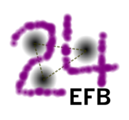Speaker
Description
Recent advances in radioactive ion beam physics and detection techniques have triggered the exploration of the exotic properties and decay modes of light nuclear systems at the limit of stability and beyond the driplines. Large experimental and theoretical efforts have been devoted to understanding the structure and reaction dynamics of loosely bound systems, such as halo nuclei, where continuum effects are of utmost relevance [1]. Of particular interest is the case of two-neutron halo nuclei, e.g., ⁶He, ¹¹Li or ¹⁴Be. These are Borromean systems, or three-body systems in which all binary subsystems cannot form bound states. While the correlations between the valence neutrons are known to play a fundamental role in shaping the properties of two-neutron halo nuclei [2], a proper understanding of their structure requires also solid constrains on the unbound binary subsystems ⁵He, ¹⁰Li or ¹³Be [3]. The evolution of these correlations beyond the driplines gives rise to two-neutron emitters, e.g., ¹⁶Be or ²⁶O [4]. A similar situation can be found for proton-rich nuclei. For instance, the Borromean ¹⁷Ne nucleus, characterized by the properties of its unbound subsystem ¹⁶F, has been proposed to exhibit a two-proton halo, while other exotic systems, such as ⁶Be and ¹¹O (the mirror nuclei of ⁶He and ¹¹Li), are two-proton emitters. Since they have a marked core+N+N character, three-body models are a natural choice to describe their structure and processes involving them [5]. The description of the continuum in three-body nuclei, however, is not an easy task. We have recently proposed a method to characterize few-body resonances by studying the time dependence of the lowest eigenstates of a resonant operator [6], with the aim of studying the population of resonances in two-nucleon emitters. The method has been applied to the two-neutron unbound system ¹⁶Be, obtaining a remarkable agreement with calculations of the true three-body continuum [7] for the 0⁺ ground-state resonance. An excited 2⁺ state, recently observed experimentally [8], is also predicted. A summary of this work will be presented. The extension to study the corresponding relative-energy distributions, as well as its application to other unbound three-body systems, will be also discussed.
[1] I. Tanihata, et al., Prog. Part. Nucl. Phys. 68, 215 (2013).
[2] Y. Kikuchi, et al., Prog. Theor. Exp. Phys. 2016, 103D03 (2016).
[3] Y. Aksyutina, et al., Phys. Lett. B 718, 1309 (2013).
[4] Z. Kohley, et al., Phys. Rev. Lett. 110, 152501 (2013).
[5] M. V. Zhukov, et al., Phys. Rep. 231, 151 (1993).
[6] J. Casal and J. Gómez-Camacho, Phys. Rev. C 99, 014604 (2019).
[7] A. E. Lovell, F. M. Nunes and I. J. Thompson, Phys. Rev. C 95, 034605 (2017).
[8] F. M. Marques, private communication (2019).

